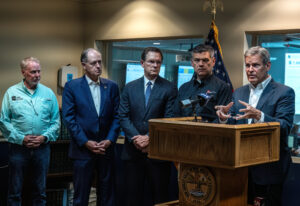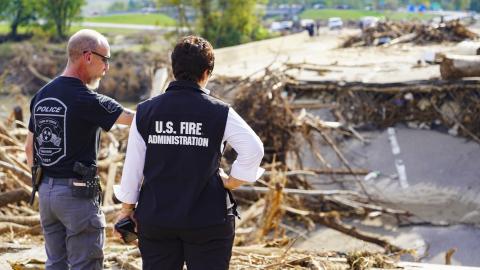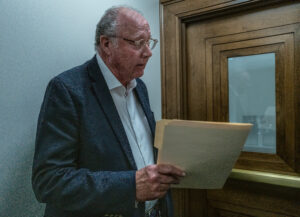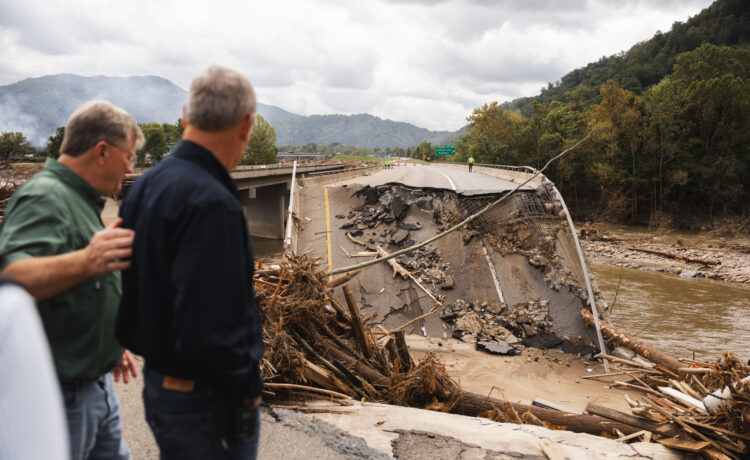In the days after Hurricane Helene unleashed catastrophic floods across parts of East Tennessee — killing 17 and inflicting hundreds of millions of dollars in damage — Gov. Bill Lee convened a series of conference calls with his cabinet members to urge his team to “think outside the box” in how to get desperately needed capital to hard-hit rural counties.
TennCare Director Stephen Smith offered up a novel idea: tap into a special savings pool within Tennessee’s Medicaid program, which draws on a combination of state and federal funds to pay the health care bills for 1.5 million Tennesseans living in or near poverty — among them pregnant women, children, seniors and those with disabilities.
Lee, who later recounted the conversation at a news conference, went with it.
The Helene Emergency Assistance Loans (HEAL) program will direct $100 million in no-interest loans from TennCare to 13 disaster-struck Tennessee counties, tapping so-called “shared savings” funds that are unique to the state’s Medicaid program.

Under federal rules, shared savings allow TennCare officials to save about half of what they do not spend each year as long as they use the funds to benefit the health and well-being of TennCare enrollees. In the first two years of the program, Tennessee achieved $600 million in savings.
But the decision has garnered pushback from some Democratic lawmakers who have questioned why Lee is pulling health care dollars from TennCare for disaster loans rather than other state funding, such as the record $2.1 billion available in the rainy day fund.
One national Medicaid expert questioned whether using the funds for disaster relief is allowed by the terms of Tennessee’s agreement with the federal government.
‘These dollars are ours’
Approved in the waning days of the Trump administration, the creation of a special TennCare fund that can be accessed for programs Medicaid doesn’t typically cover – such as additional services for maternal health, people living with disabilities and people in rural communities – has been controversial from the start.
Soon after the Biden administration took office, state and national health care organizations, including the American Lung Association, March of Dimes and American College of Obstetricians and Gynecologists (ACOG), urged federal officials to end the shared savings program, warning in an October 2022 letter to federal authorities that it created an incentive to limit services to TennCare enrollees and, instead, provided a “windfall” for state leaders to spend on programs the state budget should cover.
The shared savings “would further incentivize the state to reduce its Medicaid spending in order to generate federal funds which it could then use to invest in health programs serving people who are not eligible for Medicaid or, just as likely, to pave highways or give tax cuts,” the letter said.
“I don’t know that anyone was thinking at the time that Medicaid funds would be used for hurricane disaster relief,” said Andy Schneider, a research professor with the Georgetown Center for Children and Families, which was among more than a dozen organizations who signed on to the letter. Using the shared savings dollars for disaster loans, Schneider noted, wasn’t even on his radar.
“The federal government has disaster relief programs,” Schneider said. “This is not one of them.”
The HEAL loans are intended to cover the immediate costs of hauling debris and shoring up badly damaged utilities as a stopgap measure until FEMA disaster funding arrives in counties approved for major disaster relief funds on Oct. 2.
“These dollars are ours, they’re here, they’re available, and they’re specifically designed to be used for health and welfare,” said Lee in announcing the HEAL funding, earlier this month.
The governor acknowledged that certain planned programs for TennCare patients may need to be temporarily scrapped until counties are able to repay the $100 million in no-interest loans. Lee did not respond to questions left with his office about specific TennCare programs that could be impacted.
‘There are multiple pots of money to use instead’
State Rep. John Ray Clemmons, a Nashville Democrat, called the decision to use dollars intended for the health and welfare of TennCare enrollees “offensive.”
Tennessee has a record $2.1 billion in rainy day savings and more than $140 million in unspent funding initially set aside in the governor’s budget this year for a school voucher proposal he failed to enact. The state’s Emergency Powers act, which could give Lee broader spending powers, has not been invoked by the governor.
“The fact that their best idea was to pull $100 million from TennCare shared savings and use it for disaster loans is bizarre,” Clemmons said. “There are multiple pots of money to use instead of (TennCare funds).”
Smith, TennCare’s director, has pushed back against the criticism over Lee’s use of TennCare funding for disaster loans, noting there are 180,000 of the state’s 1.5 million TennCare recipients in the 13 counties eligible for loans.
“You’re really looking at the health and welfare of TennCare members and so in the case of hurricane relief, certainly water, wastewater, debris removal ties directly to the health and welfare of Tenncare members that live in those communities,” he said.

Schneider, the Georgetown University Medicaid expert, questioned whether disaster relief is allowed under Tennessee’s agreement with the federal government.
Among the list of prohibited uses for the funds are “capital investments,” and “expenditures that are not health-related.” Schneider also pointed to the language of the TennCare program, commonly referred to as its “waiver” designating only programs underway as of December 2020 for the funding.
“The current federal approval for TennCare is clear that the state can claim federal matching funds for certain state programs,” Schneider said. “The programs had to have been in effect since December 31, 2020. The list does not include a loan program created in October for county hurricane assistance.”
Amy Lawrence, the TennCare spokesperson, disputed Schneider’s analysis, saying TennCare has interpreted the language of the waiver to allow for the hurricane relief loan expenditures.
Lawrence also noted that the federal Centers for Medicare & Medicaid Services, which oversees state Medicaid programs,“ is aware of this plan and has expressed no concerns.
“Urgent hurricane relief for vulnerable Tennesseans is a completely appropriate use of these funds,” she said.
Urgent needs
For county mayors, local emergency officials and road supervisors in northeast Tennessee, the HEAL funding represents a critically needed down payment on the cost of removing tons of debris piles and restoring water and wastewater systems damaged or knocked offline by the Sept. 27 floods.
FEMA requires local governments to first pay out of pocket before receiving reimbursement – an impossibility for rural northeast counties facing recovery costs that exceed their annual budgets.
“The governor and his cabinet have been working closely with us and they know the needs,” said Carter County Mayor Patty Woodby, who expressed gratitude to the Lee administration for providing the loans in a local town hall meeting.

“They know rural counties cannot afford to upfront the funds, that any county that tried to do this would be in financial despair,” Woodby said.
On Tuesday, 12 days after Lee announced the emergency disaster loans, Johnson County Mayor Larry Potter said he had not yet gotten any information about how his county can apply for the funds, other than reading a press release.
Johnson County is desperate for funding, he said. The small rural county on the northeast tip of the state had extensive damage: At least 65 homes were destroyed, 44 suffered major damage, and debris piles are extensive,
He asked a reporter to “shoot me a text” if new details about how his county could access the funds emerged.
“To me, it’s like, ‘it’s in the mail. It’s coming,’” Potter said Tuesday. “It looks good on paper, but I have not seen an application (for the TennCare HEAL funds) yet.”
Later Tuesday, Potter said via text that he got his first emailed notice of how to apply for the funds at 5:27 p.m., nearly two weeks after the availability of emergency funding was announced. A state website was updated around the same time posting a link to the application
“It says ‘emergency,’’’ Potter said, referring to the acronym for the HEAL program. “Our emergency started almost two weeks ago.”
Potter credited the Tennessee Department of Transportation for showing up promptly to help restore road damage estimated to ultimately cost between $9 million and $10 million, as “the way governments should work.’’
Debris removal and road repair are among his most critical priorities as winter approaches, Potter said.
Republican Sen. Rusty Crowe, who represents Carter, Johnson and Washington counties — which all suffered Helene damage – said Thursday he planned to seek an emergency special session of the legislature in early January to call for the appropriation of additional dollars for flood-stricken counties.

“In speaking with my mayors, the HEAL dollars – although critically needed…are just the tip of the iceberg,” he said.
“I do think we have had a disastrous rainy day event,’’ said Crowe, noting he was among the lawmakers who sponsored legislation creating Tennessee rainy day funds to be used for emergencies such as this one. “We are going to have to help these counties as the cost is beyond their capabilities.”
In Carter County alone, Crowe noted, debris removal will cost between $8 and $9 million and the remaining damage assessment is about $180 million. Meanwhile the county has just $20 million in its own rainy day fund.
FEMA reimbursements for disaster expenses can take months to arrive, according to Edward Hernandez, a disaster relief consultant and vice president of the consulting firm, ICF, which works with state and local governments.
“Many communities view FEMA as the first line of defense but that is not the intention of any of these programs,” Hernandez said. “Often states do have loans made available to sub-recipients under the programs, so I think what the state is doing is a really good thing that they’re helping to alleviate some of these initial cash flow restrictions.”
The source of those state funds varies. States like Florida, which experiences repetitive disaster losses, have emergency relief funds available, he said. Other states have tapped general funds.
“I have never worked under that funding source,” Hernandez said of the HEAL funds comprised of TennCare dollars.
How TennCare landed the funding
Tennessee’s block grant is the only such Medicaid program in the nation. The grant shift federal funding for TennCare from a per-person model, in which funding is tied to actual health care costs for enrollees, to a flat annual rate of about $9 billion – a rate that fluctuates with the cost of medical inflation. It was under this novel block grant arrangement that the shared savings plan was approved by the federal government.
The state of Tennessee picks up about a third of the total cost of TennCare with the federal government paying the rest.
Tennessee’s block grant received federal approval in early January 2021 – the last week of the Trump administration, with the newly created “shared savings” model.
The decision was challenged three months later by the Tennessee Justice Center, a Nashville public interest law firm that represents TennCare users.
It also drew sharp opposition from a spectrum of health care organizations who urged the Biden administration to claw it back, warning it would “undermine the Medicaid program in Tennessee” and “create a windfall of federal funds to Tennessee.”
The Biden administration subsequently revised portions of the block grant agreement, leaving the shared savings provision in place but adding some new limits on the amount of savings the state could accrue and tying the state’s ability to capture those dollars to performance metrics.
In its first two years the state accrued about $600 million in shared savings, money that has already been allocated to rural health and mental health programs, along with a free diaper program for new mothers on TennCare. The funds being directed to disaster loans come from the third year of shared savings, according to TennCare.














